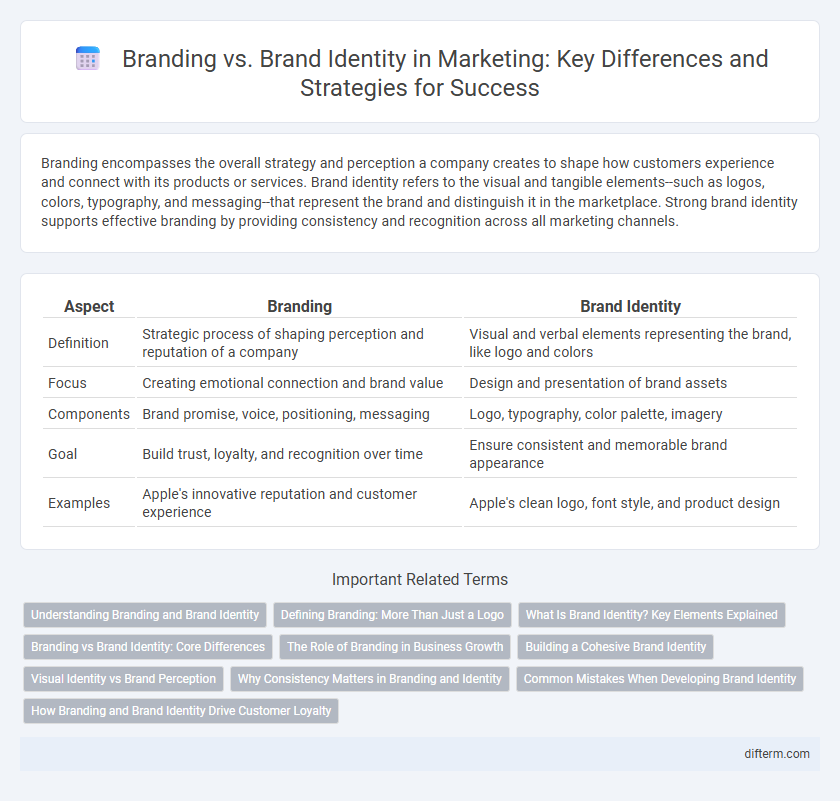Branding encompasses the overall strategy and perception a company creates to shape how customers experience and connect with its products or services. Brand identity refers to the visual and tangible elements--such as logos, colors, typography, and messaging--that represent the brand and distinguish it in the marketplace. Strong brand identity supports effective branding by providing consistency and recognition across all marketing channels.
Table of Comparison
| Aspect | Branding | Brand Identity |
|---|---|---|
| Definition | Strategic process of shaping perception and reputation of a company | Visual and verbal elements representing the brand, like logo and colors |
| Focus | Creating emotional connection and brand value | Design and presentation of brand assets |
| Components | Brand promise, voice, positioning, messaging | Logo, typography, color palette, imagery |
| Goal | Build trust, loyalty, and recognition over time | Ensure consistent and memorable brand appearance |
| Examples | Apple's innovative reputation and customer experience | Apple's clean logo, font style, and product design |
Understanding Branding and Brand Identity
Branding encompasses the overall strategy and perception that shapes how a company is recognized and emotionally connected with its target audience. Brand identity refers to the tangible elements like logos, color schemes, typography, and design that visually represent and differentiate a brand in the marketplace. Understanding the distinction helps businesses develop consistent messaging and visual cues that reinforce brand recognition and loyalty.
Defining Branding: More Than Just a Logo
Branding encompasses the comprehensive set of strategies and perceptions that shape how a company is recognized, including its values, mission, and customer experience. It goes beyond visual elements, influencing emotional connections and market positioning to create lasting impressions. Effective branding drives customer loyalty and distinguishes a business in competitive markets by conveying consistent messages and promises.
What Is Brand Identity? Key Elements Explained
Brand identity is the visual, verbal, and experiential elements that distinguish a brand in the marketplace, encompassing logos, color palettes, typography, and tone of voice. Key elements include brand name, logo design, tagline, brand colors, typography, and consistent messaging aligned with core values and target audience preferences. This cohesive combination fosters brand recognition, emotional connection, and trust with consumers essential for effective marketing strategies.
Branding vs Brand Identity: Core Differences
Branding encompasses the overall strategy to shape consumer perception through messaging, values, and experiences, while brand identity refers to the visual and tangible elements such as logos, color schemes, and typography that represent the brand. Branding drives emotional connections and brand loyalty, influencing how customers feel and engage with a company. Brand identity serves as the physical manifestation of branding and ensures consistent recognition across all marketing channels.
The Role of Branding in Business Growth
Branding establishes a distinct market presence that drives customer loyalty and differentiates a business from competitors, directly impacting revenue growth and market share expansion. Brand identity, encompassing visual elements and messaging, supports this by creating consistent recognition and reinforcing trust among target audiences. Effective branding strategies forge emotional connections, encouraging repeat business and facilitating long-term customer engagement essential for sustained business growth.
Building a Cohesive Brand Identity
Building a cohesive brand identity requires aligning visual elements, messaging, and values to create a consistent and recognizable presence across all marketing channels. Effective brand identity differentiates a company in competitive markets and fosters trust with target audiences by reflecting core brand attributes accurately. Strong brand consistency enhances customer loyalty and drives long-term business growth through clear and unified communication.
Visual Identity vs Brand Perception
Branding encompasses the strategic process of shaping a company's reputation and emotional connection with its audience, while brand identity specifically refers to the visual elements such as logos, color palettes, and typography that distinguish the brand. Visual identity serves as the tangible expression of a brand's personality, directly influencing brand perception by creating consistent, memorable experiences across all marketing channels. Effective alignment between visual identity and brand perception ensures stronger customer recognition, trust, and loyalty in competitive markets.
Why Consistency Matters in Branding and Identity
Consistency in branding and brand identity ensures a cohesive message across all customer touchpoints, strengthening brand recognition and trust. Maintaining uniform visual elements, tone, and values helps distinguish the brand in competitive markets and fosters customer loyalty. This alignment enhances perceived professionalism and supports long-term business growth through sustained brand equity.
Common Mistakes When Developing Brand Identity
Common mistakes when developing brand identity include confusing it with branding, leading to inconsistent messaging and weak visual elements. Neglecting thorough market research results in a brand identity that fails to resonate with the target audience or differentiate from competitors. Overcomplicating design or ignoring brand guidelines diminishes recognition and weakens overall brand equity.
How Branding and Brand Identity Drive Customer Loyalty
Branding encompasses the strategic process of shaping customer perceptions and emotional connections with a company, while brand identity includes the visual, verbal, and experiential elements that represent the brand. Strong branding builds trust and consistent messaging, which reinforces customer loyalty by creating memorable and reliable experiences. Clear and cohesive brand identity ensures recognition and fosters emotional attachment, driving repeat purchases and long-term customer retention.
Branding vs Brand Identity Infographic

 difterm.com
difterm.com